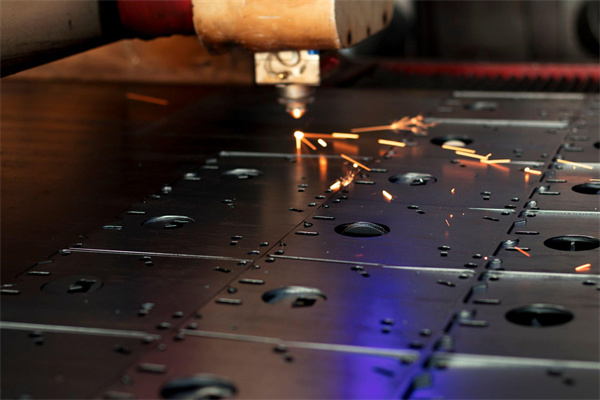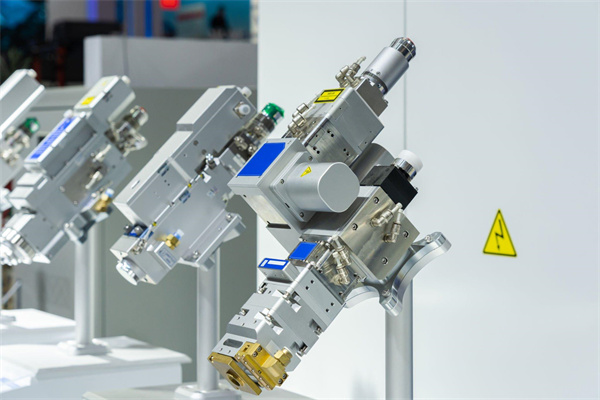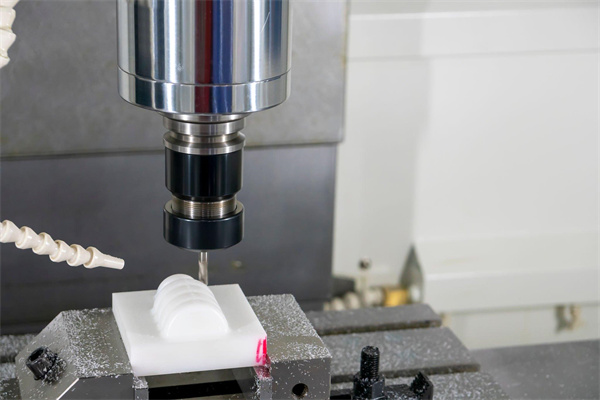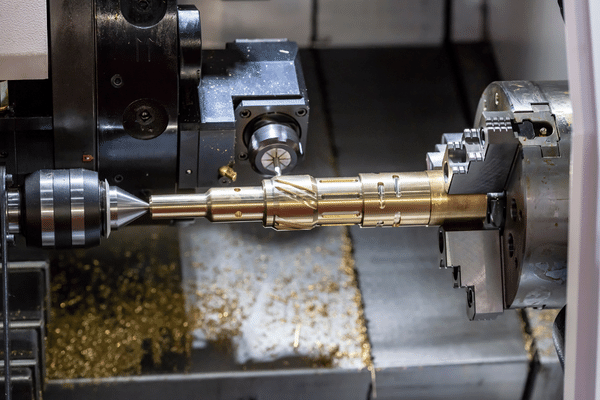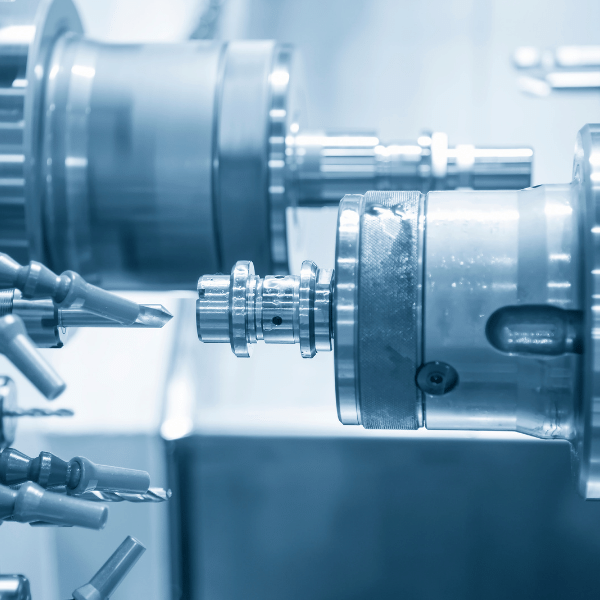[lwptoc]
What is a CNC machine, and what can it be used for
A Computer Numerical Control (CNC) machine is a powerful tool used in industry to shape and cut parts from various materials. CNC machines are used to create precision parts such as components for medical implants, aircraft engines, aerospace components, and automotive engines. They can also be used in the creation of furniture and artwork.
The modern CNC machine uses computer software to control the machine’s movements and to cut speed, allowing for precise cuts and shapes that would otherwise be impossible to replicate by hand. To use a CNC machining center, an operator must design the part they want on their computer using CAD/CAM software. This CAD/CAM file is then sent to the machining center, which will interpret it into commands that tell the machine how to move, what tooling should be used, at what speed, and with what feeds and speeds the part should be cut or shaped.
The operator then loads the program onto the CNC machine’s controller. The controller contains all the instructions necessary to carry out each operation step, including selecting tools, setting tool heights, changing spindle speeds and acceleration rates, and controlling coolant flow. Once this is done, all that is left for the operator to do is push start!
Using a CNC machine allows for extreme accuracy when cutting complex shapes or intricate parts with complex contours due to its ability to precisely control its movements on multiple axes simultaneously. The increased accuracy of a CNC will also help reduce waste produced during production runs since it can accurately cut each piece desired without wasting valuable material resources. Furthermore, CNC machines can quickly produce multiple copies of a single part, making them ideal for mass-production applications where precision is crucial.
Finally, because most modern machines are equipped with lubrication systems and automatic tool changers, it allows operators to work more efficiently with less downtime spent performing maintenance tasks or changing tools manually like they would have had to do in years past when using manual machinery.
In conclusion, there are many reasons why companies choose a CNC machine over traditional manual machining: greater accuracy leading to higher quality parts; faster production runs; less wasted material; fewer maintenance tasks requiring manual labor; and reduced human error leading to fewer scrap pieces being created in production runs compared to manual operations if you’re looking for an efficient way to produce high-quality precision parts, consider investing in one of today’s sophisticated CNC machines!
How to use a CNC machine – the basics
CNC (Computer Numerical Control) machines are automated tools used in industrial manufacturing and other related industries. These machines can create specific products with incredible detail, accuracy, and speed. The following guide is intended to provide a basic overview of the process for anyone looking to learn how to use these powerful tools.
Before getting started, it is important to understand some of the main components of a typical CNC machine. The head holds the cutting tool and moves across three axes: X, Y, and Z. Each axis have a motor that provides smooth motion along that axis. Additionally, most CNC machines contain a spindle, which rotates at different speeds and directions as needed for each project’s requirements. A control panel is also attached for monitoring and controlling all operations.
The first step in learning to use a CNC machine is becoming familiar with the software programs used to control its operation. Many machines come pre-loaded with manufacturer-specific software, but many third-party options are also available. Most programs offer features such as CAD/CAM applications and even integration with external systems such as ERP (enterprise resource planning). Once you have chosen your software program(s), you will need to set up your workspace according to the instructions provided by the manufacturer or programmer who created it.
Next, you will need to create a design or blueprint (model) of what you would like the finished product to look like using manual drafting methods or digital modeling software such as AutoCAD or SolidWorks. This file must be written in G-code so the machine can interpret it correctly when producing your product from start to finish.
Once your G-code file has been written, you can begin operations on your CNC machine by turning on power and loading your code into its memory bank via either a USB drive or directly from an online source, if applicable for your specific machine model. At this point, it is an important safety measure for all operators working near or around any moving parts on the device; these should be taken seriously at all times! After verifying that all settings are correct, you can start machining operations by pressing ‘start’ on the control panel’s interface screen. As machining progresses, monitors will display real-time data-related factors such as speed, feed rate, spindle RPMs, etc……..…so operators can keep track of their progress throughout production runs, ensuring accurate results every time!
In conclusion, while becoming proficient in operating a CNC machine requires practice and experience, having a basic understanding of how they work provides an excellent foundation upon which one can build over time! By following these simple steps, you will be able to use these powerful tools efficiently to produce quality results with great accuracy and speed – perfect for those who want to get involved in industry-level production without necessarily needing years of skill development beforehand!
Advanced tips and tricks for using a CNC machine
Using a CNC machine can be intimidating at first, but with some practice, anyone can learn how to make precision parts with complex shapes. With the right knowledge and experience, you can create intricate designs and take your project to the next level. This blog post will discuss advanced tips and tricks for using a CNC machine to maximize accuracy and efficiency while reducing material waste.
Before getting started, it’s important to understand the basics of CNC machines. CNC stands for computer numerical control, a type of automation machine specifically designed for machining metal and other materials with high precision. These machines use computer-aided manufacturing (CAM) software programs to control the cutting tools to achieve the desired shape or design. The result is a finished part cut with high accuracy and minimal material waste.
G-code programming is one of the best ways to increase accuracy when using a CNC machine. This type of programming allows users to specify different parameters such as toolpaths, feed rates, speeds, depths of cuts, coolant levels, etc. Using G-code programming makes it easier to ensure that all of these settings are programmed correctly to achieve the desired outcome while minimizing material waste. Additionally, G-code programming can help reduce cycle times, saving time and money during production runs.
One tip many experienced machinists swear by is double-checking your work before sending it off for production runs to maximize efficiency while using a CNC machine. This means reviewing all settings one more time to confirm everything looks correct before running cycles on the machine itself. This will reduce the risk of errors and save time since corrections won’t have to be made after the fact. It’s also important to consider any setup times involved in switching between different materials or shapes, as these will also affect overall cycle times.
Another way to improve accuracy when using a CNC machine is by paying attention to cutting speeds and feeds when machining different materials or shapes. Different metals require different speeds and feed to be cut effectively without damaging the tooling or the material itself. Knowing what speed and feed rate work best for each job will ensure quality results, minimize tool wear over time, and minimize material waste due to incorrect settings.
Finally, another great way for users of CNC machines to increase efficiency is by finding ways to automate processes where possible. For instance, many CAM programs include features such as automated nesting, which helps users optimize their material usage and reduce costs associated with excess scrap material produced from parts cut too large or too small from incorrect settings used during machining operations. Other automation features, such as automatic tool path generation, can also help reduce programming time since CAM software does much of this work automatically based on parameters specified by users beforehand, thus saving valuable time during production runs.
Overall, learning how to use a CNC machine properly takes practice, but following these tips should help get you started toward becoming an expert machinist who produces quality parts with minimal effort while reducing wasted resources along the way!
The benefits of using a CNC machine
Modern manufacturing relies heavily on CNC machines or Computer Numerical Control machines. CNC machines are programmable cutting tools that allow precise control over a part’s shape and size. This makes them ideal for various applications, from automotive parts manufacturing to woodworking and jewelry.
CNC machines offer several advantages over traditional manual machining methods. For starters, they are much faster than manual machining methods due to their automated nature. This speed allows manufacturers to increase production while reducing the cost and time spent on each project. CNC machining is extremely accurate and repeatable, leading to consistently high-quality parts.
In addition to increased speed and accuracy, using a CNC machine also offers improved safety for workers since it eliminates the need for them to interact with sharp cutting tools. Furthermore, CNC machines can be operated remotely via a computer interface or even through smartphones — reducing the need for human labor in certain instances — further contributing to improved operational safety.
The programming associated with operating a CNC machine can be complex at first glance but has become increasingly user-friendly as technology has advanced over time. Many modern software programs make programming intuitive and relatively simple compared to earlier iterations of these systems, allowing operators with minimal experience to benefit from their use quickly. Additionally, most CNC systems have built-in safety features that protect users from potential harm when programming or making adjustments during operation.
Learning how to use a CNC machine can take some time and practice but doing so can provide many long-term benefits to businesses, such as reduced costs associated with training new employees and improved product quality due to consistent outcomes across multiple projects or batches of products produced on the same machine. Additionally, as automation advances and becomes more widely adopted by industry leaders across sectors in different countries, familiarity with modern machinery like CNC will become an increasingly valuable asset in helping businesses remain competitive in their respective markets.
How to find the best CNC machine for your needs
Finding the best CNC machine for your needs can be a daunting task. With so many options available, it’s important to understand what’s offered to ensure you choose the right one for your specific requirements. In this blog post, we’ll walk through the steps of effectively using a CNC machine and offer tips for finding the best one for your needs.
First, it’s important to consider what type of CNC machine best suits your project. There are two main types of machines; manual and computer-controlled (CNC). Manual machines are ideal for short-run production and repetitive tasks, while CNC machines are great for larger projects with more complex designs. Depending on the size and complexity of your project, it’s important to choose the right type of machine that will suit your needs.
Once you know which type of CNC machine is right for you, it’s time to look into features such as accuracy, speed, resolution, and repeatability. Accuracy is key when using a CNC machine, as any inaccuracies result in an unsatisfactory product. A good rule of thumb is selecting a machine with an accuracy rating of 0.0005 mm or 0.00002 inches per inch. Additionally, speed is important as it affects how quickly tasks can be completed without sacrificing accuracy or quality.
It’s also important to look into resolution features when selecting a CNC machine; this will determine how precise movements will be achieved throughout the production process. The higher resolution a machine offers, the more accurate your finished product will be, and ultimately, this could save you time and money in corrections or rework down the line. Finally, repeatability should also be considered; this feature ensures that each cycle runs accurately by eliminating small variations between cycles due to wear on components or other variables outside the operator’s control.
When shopping around for a new CNC Machine, it pays off to research beforehand so you know what model suits your project specifications best to get optimal results from it in terms of costs, efficiency, and precision level needed. Researching existing models on the market can help you compare specifications side by side and help make better decisions regarding which one is more suitable based on various factors like price range, material capabilities being worked with, etcetera.
Another practical tip when looking at different models available is comparing them not just by their specs but by reputation too – although newer models may carry certain advantages due to their modern features, there might be older but reliable models out there still offering solid performance and worth taking into consideration if budget constraints play a vocal role here too.
Finally, an often overlooked aspect that might save considerable amounts in the long run would be the availability of spare parts. Even though these usually come at different costs from buying the main unit itself, making sure local suppliers stock these parts can prove helpful if something goes wrong during the production phase due to wear & tear or any other reason related; having quick access is not only saves time but also helps workflow stay uninterrupted with minimum disruptions along the way.
Ultimately choosing the right machinery requires careful consideration since mistakes here could have major implications in terms of both finances & productivity; therefore, taking a little extra time while researching prospective manufacturers & their available offerings surely pays off in the long run.
The cost of owning and operating a CNC machine
Many industries have increased project efficiency and accuracy with the emergence of computer numerical control (CNC) machines. CNC machines are automated and offer unparalleled precision for various applications. However, investing in these machines is no small feat, as they can come with a hefty price tag. This blog post will examine the costs associated with owning and operating a CNC machine.
When evaluating the cost of owning and operating a CNC machine, it’s important to consider the upfront costs of purchasing the machine and any ongoing expenses that may be incurred for upkeep or maintenance. Purchasing a CNC machine can be expensive, depending on the type or brand you choose. For instance, a basic 3-axis CNC router can cost anywhere from $2,000-$7,000, while a larger 5-axis machine could run up to $50,000 or higher. Additionally, these machines require regular maintenance and repairs, which can add up over time.
On top of buying the machine itself and paying for repairs and maintenance, additional costs are associated with setting up the machine and getting it ready to use. This setup process usually requires specialized software purchased separately from the machine itself. Depending on which software is selected, this could add several thousand dollars to your final bill. Also, most machines will need some safety features installed to protect workers from potential harm caused by working with such powerful tools. Again, this could mean another expenditure for owners looking to get their machines up and running properly.
Additionally, you’ll need other materials, such as tooling bits or cutting heads for your particular project,t, which will add to the total cost. And don’t forget about labor costs; if you don’t plan on operating the machine yourself, you may need to hire an experienced operator who knows how to use it effectively. This cost should also be taken into account when calculating your total expense.
Overall, owning and operating a CNC machine can be expensive but can also be very beneficial in terms of efficiency when completing tasks related to production workflows or prototyping projects due to its high level of accuracy compared to manual processes like drilling or milling by hand. With careful consideration and planning ahead for potential expenses related to purchasing materials or hiring help if necessary, businesses should be able to make informed decisions about whether investing in one of these machines would make sense for them financially in the long run based on their specific needs and requirements.


